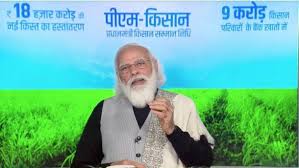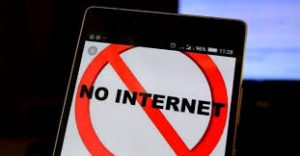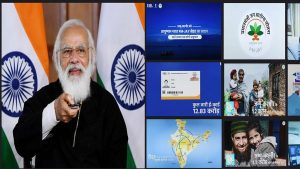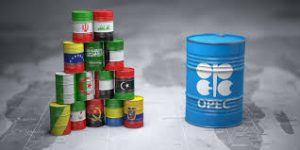Daily Current Affairs for Government Exams:
Today Current Affairs: 26th December 2020 for UPSC IAS exams, State PSC exams, SSC CGL, State SSC, RRB, Railways, Banking Exam & IBPS, etc
Table of Contents
Contents:
- Next Instalment of PM-KISAN
- J&K Internet ban extended:
- Ayushman Bharat PM-JAY SEHAT:
- Data from Chandrayaan-2 Released: ISRO
- OPEC+:
- other important current affairs
1.Next Instalment of PM-KISAN:

The Prime Minister has virtually released the next instalment of financial benefit under Pradhan Mantri Kisan Samman Nidhi (PM-KISAN).
- Rs. 18000 crores have been deposited in the bank account of more than 9 crore farmers through Direct Benefit Transfer (DBT).
- More than 1 lakh 10 thousand crore rupees have reached the account of farmers, since this scheme started in February 2019.
Pradhan Mantri Kisan Samman Nidhi:
- Launched in February 2019, it is a Central Sector Scheme, which is being implemented by the Ministry of Agriculture and Farmers Welfare.
- On its first anniversary, the PM-KISAN Mobile App developed and designed by the National Informatics Centre (NIC) in collaboration with the Ministry of Electronics and Information Technology was launched.
- Under the scheme, the Centre transfers an amount of Rs. 6,000 per year, in three equal instalments, directly into the bank accounts of the all landholding farmers irrespective of the size of their landholdings.
- The entire responsibility of identification of beneficiary farmer families rests with the State/UT Governments.
- It aims to:
- Reduce the input cost of the farmers.
- Ensure a fair price for the crop.
- Open new markets for the farmers to sell their crop.
- Supplement the financial needs of the Small and Marginal Farmers (SMFs).
2.J&K Internet ban extended:

The Jammu and Kashmir administration has extended the ban on 4G mobile Internet up to January 8, saying “the restrictions on the high-speed connectivity acted as an impediment to attempts” of the militants to disturb the District Development Council (DDC) polls.
- An order issued by the Jammu and Kashmir Home Department noted that there were credible inputs about the presence of a large number of militants trying to infiltrate from across the border.
Supreme Court’s ruling in 2020:
- Supreme Court on May 11 refused to restore 4G internet in Union Territory of Jammu & Kashmir.
- But, the Court had ordered the Centre and Jammu and Kashmir administration to form a committee of Secretaries from MHA and J&K UT Admin to take a call after reviewing the ground security situation.
- The high-powered Committee headed by the MHA Secretary will also look into the contentions raised by various petitioners.
- There is a need to ensure that national security and human rights are balanced.
- J&K UT has plunged into crisis, but at the same time there are concerns related to ongoing pandemic and hardships.
- The bench also referred to its earlier decision in the Anuradha Bhasin case (2020) wherein it ordered review of restrictions placed in J&K in the wake of abrogation of Article 370 of the Constitution.
Background:
- In August 2019, the Central government had suspended all modes of communications in the wake of revocation of Jammu and Kashmir’s special status, granted under Article 370. Eventually, services were partially restored, with internet speed restricted to 2G.
- A plea was filed by ‘Foundation for Media Professionals’ for restoration of high-speed internet in Jammu and Kashmir in view of the Covid-19 situation.
- But, the administration opposed restoration of 4G services in the union territory. It justified its move in view of protecting the sovereignty, integrity and security of the country.
3.Ayushman Bharat PM-JAY SEHAT:

PM Modi to launch the Ayushman Bharat Pradhan Mantri Jan Arogya Yojana (AB-PMJAY) SEHAT scheme for the residents of Jammu and Kashmir.
About the Scheme:
- SEHAT scheme stands for Social, Endeavour for Health and Telemedicine, a health insurance scheme for the Union Territory.
- The Scheme provides free of cost insurance cover to all the residents of the UT of J&K.
- It provides financial cover up to Rs.5 Lakh per family on a floater basis to all residents of the UT of J&K.
- It provides for an operational extension of PM-JAY to 15 lakh (approximately) additional families.
About PM- JAY:
- The PM-JAY, world’s largest health insurance/assurance scheme fully financed by the government, provides a cover of Rs 500,000 per family per year for secondary and tertiary care hospitalisation across public and private empanelled hospitals in India.
- The benefit of Rs 5,00,000 is on a family floater basis, which means that it can be used by one or all members of the family.
- It covers medical procedures such as oncology, cardiology, nephrology etc and up to three days of pre-hospitalisation and 15 days post-hospitalisation expenses such as diagnostics and medicines are also included in the scheme.
4.Data from Chandrayaan-2 Released: ISRO

The Indian Space Research Organisation (ISRO) has released the first set of data from the country’s second mission to the Moon, the Chandrayaan-2, for the general public.
- India launched Chandrayaan-2, its second lunar exploration mission after Chandrayaan-1, from Satish Dhawan Space Centre, Sriharikota on 22nd July 2019.
- ISRO is planning mission Chandrayaan-3 in late 2021 or early 2022.
Standard Requirement for Public Release of Data:
- The Chandrayaan-2 data is required to be in the Planetary Data System-4 (PDS4) standard and is required to be peer-reviewed scientifically and technically before acceptance as PDS archives and declared ready for sharing with the global scientific community and the general public.
- This activity has been completed and hence the first set of data from the Chandrayaan-2 mission is now being released for the wider public use through the PRADAN portal hosted by Indian Space Science Data Centre (ISSDC).
- ISSDC is the nodal centre of planetary data archive for the planetary missions of ISRO.
Current Data:
- The ISRO Science Data Archive (ISDA) currently holds data sets acquired by Chandrayaan-2 payloads from September-2019 to February-2020 from seven instruments.
- ISDA is the long-term archive for ISRO planetary missions.
- All experiments have been performing well and the data received suggests excellent capability to deliver on the pre-launch promises.
Chandrayaan-2:
- It is an integrated 3-in-1 spacecraft of around 3,877 kg consisting of an Orbiter of the Moon, Vikram (after Vikram Sarabhai) – the lander and Pragyan (wisdom) – the rover, all equipped with scientific instruments to study the moon.
- The Chandrayaan-2 was India’s first attempt to land on the lunar surface.
- ISRO had planned the landing on the South Pole of the lunar surface.
- However, the lander Vikram hard-landed in September last year. Its orbiter, which is still in the lunar orbit, has a mission life of seven years.
- Objective:
- Try and build on the evidence of water molecules shown by Chandrayaan-1 and study the extent and distribution of water on the Moon.
- Study topography, seismography, composition of lunar surface and the lunar atmosphere.
- The study of ancient rocks and craters can offer indications of origin and evolution of the Moon.
- The South Pole region of the Moon also contains clues to the fossil records of early solar systems. Thus, it can improve our understanding of the early solar system as well.
- Map the lunar surface and prepare 3D maps of it.
5.OPEC+:

Russia expects to support an increase in oil production by OPEC+, of another 500,000 barrels per day (bpd) from February at next month’s summit of the leading global oil producers.
- Russia, other leading oil producers and the Organization of the Petroleum Exporting Countries, a group known as OPEC+, agreed to reduce output to support the global oil market as the COVID-19 pandemic has weakened fuel demand.
- Since the agreement on a record global supply cut in April, OPEC+ has progressively reduced the cuts and is expected in January to release an extra 5,00,000 bpd into the market.
Opec+:
- Opec+ refers to the alliance of crude producers, who have been undertaking corrections in supply in the oil markets since 2017.
- OPEC plus countries include Azerbaijan, Bahrain, Brunei, Kazakhstan, Malaysia, Mexico, Oman, Russia, South Sudan and Sudan
Other important current affairs:
1.The Ministry of Information and Broadcasting (I&B) has recently approved revised guidelines for Direct-to-Home (DTH) broadcasting services, allowing 100% Foreign Direct Investment (FDI) as well as increasing the licence period to 20 years.
- Direct-To-Home (DTH) Broadcasting Service refers to the distribution of multi channel TV programmes in Ku Band by using a satellite system by providing TV signals direct to subscribers’ premises.
- Ku-band is a portion of the electromagnetic spectrum. It is best known for its use in satellite broad`cast communications.
- Ku-band falls in the middle in terms of frequency, utilizing the approximate range of 12-18 GHz of radiofrequency.
- License Duration: The licenses will be issued for a period of 20 years, compared to 10 years at present and will be renewed for a 10-year period.
2.Rajasthan Chief Minister Ashok Gehlot has said the Amendment Bills passed in the State Assembly last month to counter the Centre’s farm laws were held up in Raj Bhavan, as the Governor was not sending them for Presidential assent.
- The Union government was not willing to accept that the Bills were in “public interest”, he said.
- Article 200 of the Indian Constitution deals with the powers of the Governor with regard to assent given to bills passed by the State legislature and other powers of the Governor such as reserving the bill for the President’s consideration.
- According to Article 200, when a Bill, passed by the Legislature of a State, is presented to the Governor, he has four options:
- He assents to the Bill
- He withholds assent
- He reserves the Bill for the consideration of the President
- He returns the Bill to the Legislature for reconsideration.
- Options before the President:
- When a Bill is reserved by a Governor for the consideration of the President, the President shall declare either that he assents to the Bill or that he withholds assent therefrom Provided that:
- Where the Bill is not a Money Bill, the President may direct the Governor to return the Bill to the House or, as the case may be, the Houses of the Legislature of the State together with such a message as is mentioned in the first proviso to article 200.
- When a Bill is so returned, the House or Houses shall reconsider it accordingly within a period of six months from the date of receipt of such message and, if it is again passed by the House or Houses with or without amendment, it shall be presented again to the President for his consideration.
3.The Indian Institute of Science Education and Research (IISER) has recognized the BBX11 gene that facilitates the greening of crops.
- The researchers discovered a mechanism where two proteins oppositely regulate the BBX11 gene to maintain optimum ranges of BBX11.
- BBX11 plays a vital role in regulation of the amount of protochlorophyllide synthesized by the plant.
- Protochlorophyllide is an intermediate in the synthesis of chlorophyll.
- If it is less, plants are unable to efficiently green in order to harvest sunlight and if the amount of protochlorophyllide is more, then photobleaching occurs.
- Photobleaching is loss of colour by a pigment.
- The quantity of protochlorophyllide synthesised needs to be proportional to the variety of enzymes available to transform them to chlorophyll.
- It is very important to regulate the amount of protochlorophyllide synthesized by the plant.
4.The National Tiger Conservation Authority has asked Odisha to submit a status report on the adverse impact of tourism on Satkosia Tiger Reserve.
- Satkosia Tiger Reserve, Bhubaneswar comprises two adjoining sanctuaries of central Odisha named as Satkosia Gorge Sanctuary and Baisipalli Sanctuary.
- These two sanctuaries together covering an area of 963.87 sq km were notified as Tiger Reserve in December 2007.
- Lying in a transitional zone extending between the Chhota Nagpur Plateau and the Deccan Plateau, the tiger reserve exhibits endemic life forms of both biotic provinces.
5.The Indian Army is going to approach the Defence Ministry for a waiver to take the Kamov-226T (Ka-226T) utility helicopters with Russia.
- In 2015, India and Russia concluded an Inter-Governmental Agreement (IGA) for 200 Ka-226T helicopters estimated to cost over USD 1 billion.
- The Kamov-226T is meant to replace the ageing and obsolete Cheetah and Chetak fleets of the Indian Army and the Air Force.
- About Kamov-226T helicopter:
- Design: The Ka-226T is a design of Russia’s famed Kamov design bureau.
- Assembling: A joint venture India Russia Helicopters Limited (IRHL) has been set up between Hindustan Aeronautics Limited (HAL) and Russian Helicopters (RH) which will assemble the helicopters in India.
- Payload Capacity: It is a light helicopter, with a maximum take-off weight of over 3.5 tonnes and can carry a payload of up to 1 tonne.
- The Ka-226T uses coaxial rotors, that is, it has two sets of rotors mounted one on top of the other and typically no tail rotor.
- Coaxial rotors give a helicopter improvements in lift and payload capacity over conventional choppers.
- This is especially advantageous in high-altitude environments where an aircraft’s performance at take-off tends to diminish due to the lower air density.
- The Ka-226T also has a unique, detachable ‘mission’ compartment instead of a conventional cabin.
- This allows the helicopter to be adapted for different roles such as surveillance and cargo delivery.




